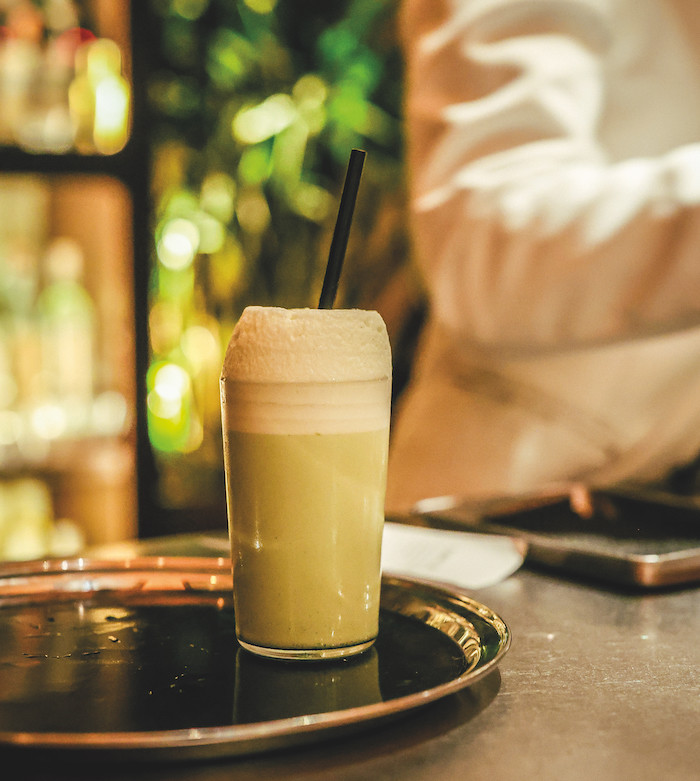
It’s become a major hit thanks to a post that went viral on a Chinese social media app. Tyler Zielinski probes the rise of the ‘yoghurt’ drink.
Fifty six Ramoses on Saturday…” reads a text from the inimitable Erik Lorincz, owner of Kwant Mayfair, one day this winter. Unless they’re a glutton for punishment and sore shoulders, it’s a sentence daunting enough to make any veteran bartender shiver with dread.
By any standards, serving 56 off-menu Ramos Gin Fizzes in an evening is, frankly, absurd – let alone on a busy Saturday night service when the cobbler shaker-manned bar staff are already in the weeds (Kwant would go on to break that record the following week, selling a gobsmacking 69 Ramos Gin Fizzes in one night).
The writing was on the wall for the infamously laborious boozy milkshake, though. Its growth was a slow burn, starting in the summer after Lorincz made one for a regular guest who’d seen him demonstrate the cocktail in a 2018 Youtube video posted by Dean Callan and wanted to try it for herself.
“She came in on a slow summer evening and asked for a Ramos Gin Fizz, saying she saw me make one online so, of course, I obliged,” says Lorincz. “After I made it, she snapped a few photos of the drink, then posted them on Little Red Book, a Chinese social media app.”
A couple of months later, around October 2024, the same guest came back in, and Lorincz asked her about the photos she took, only for her to start laughing, disclosing that her post received “so many comments” on Little Red Book. She showed Lorincz and team the viral post. Shortly after her revisit, Lorincz and his team noticed droves of young Chinese guests coming into the bar. They’d show the bar staff pictures of the Ramos Gin Fizz from Little Red Book – without actually knowing the name of the drink – and order it. Then they’d take pictures of their own to share on the app.
Suddenly, one evening in October, Kwant served 25 Ramoses without it being featured on the menu. And its popularity has endured and flourished ever since, with the bar expanding its offering to matcha and yuzu variations – the new bestsellers – as well for its Ramos-thirsty guests.
Further upticks
While Kwant may be ground zero for the Ramos Gin Fizz boom in the UK – and possibly globally – it isn’t the only one to be hit by the Ramos craze. Nearby at the Connaught Bar, assistant director of mixology Giorgio Bargiani says the bar has also seen an uptick in Ramos Gin Fizz orders, going from only a few every year to up to 10 or 12 a night on some evenings – all orders by young Chinese guests who reference the cocktail on Little Red Book.
Across town in Haggerston, at Bar Lotus, which also has five sites across China and actively posts on Little Red Book, Chinese guests have been on the Ramos kick, too. “From October to January, we have sold roughly 100 Ramos Gin Fizzes, with 12 being the most we’ve served in an evening,” claims Bar Lotus’s owner and director Noa Wang, who notes that the bar sold less than 15 Ramoses in total the previous year. But instead of offering the classic, Bar Lotus only offers an Ube & White Chocolate Ramos Gin Fizz made with rum instead of gin, white chocolate liqueur, ube cream, citrus and egg white (off-menu, of course). “We created our special Ramos Gin Fizz for customers who want it, as we try to stand out from the classic ones,” says Wang.
“We prepared several highball glasses just for the cocktail and trained our bartenders how to make a perfect one.” Bar Lotus has been posting its eye-catching, purple-hued Ramos on Little Red Book, and it has caught traction among those on the app. Wang notes that his sister bar in Shanghai is also serving a lot of Ramos Gin Fizzes at the moment.
While the trend does seem to be mostly limited to major cities, with Shinji’s – a Japanese-influenced cocktail bar in New York City – also noticing a similar phenomenon among its guests, the Ramos Gin Fizz has also become an unlikely popular order at Passing Fancies in Birmingham. “It all started with an interview Zidan, one of our bartenders, did with someone for Little Red Book in Birmingham talking about drinks,” says owner and bartender Matt Arnold. “We have an in-house joke about Ramoses because some of the team hate making them, while some of us absolutely love it. So we’ve started making a few for guests and noticed that it was getting put on to Little Red Book.” Arnold adds that, for every two Chinese students who come into the bar, at least one of them orders the ‘yogurt’ drink as it’s referred to among those on the app due to the cocktail’s sour and creamy character.
It begs the question: has the Ramos Gin Fizz finally made the improbable leap from a cult classic cocktail reserved for in-the-know bartenders, to a consumer favourite that bartenders are happy to churn out, despite the labour required to execute one? All signs are pointing to yes.
At Amaro Bar, guests can go off menu to try its bartender-backed Strawberry & Vanilla Ramos; Scarfes Bar has sold over 1,600 of its Ramos & Eve, a signature twist on the classic made with pineapple, cream, pandan, acorn, tequila and a delicate dusting of matcha tea (a Ramos-meets-Piña Colada-style serve); and on its previous menu, which finished in October 2024, Fox & Chance in Birmingham sold 542 of its passion fruit and bergamot-flavoured Ramos Gin Fizzes in the six months the menu was live, with guests coming back and specifically asking for that drink, despite it no longer being available.
“I think it has the potential to become the new Mojito,” Lorincz cheekily claims. “Other guests who aren’t on the app have started taking notice of the drink because it’s on so many tables, and whenever I explain what it is to them, they often try it – and the feedback has been good.” Whether or not Lorincz’s hot take will come to fruition, only time will tell. But one thing is for certain: if you don’t stock double cream and orange blossom water at your bar, you’d best go pick some up at the shops, because the Ramos is coming.
And if Kwant’s trajectory is anything to go by, you’d be a fool not to lean in as the marketing and business benefits speak for themselves.


